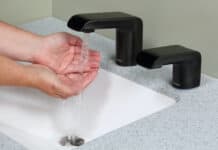Seven weeks have passed since Chinese health authorities informed the World Health Organization (WHO) that there were mounting cases of pneumonia in the city of Wuhan. Within a short period of time, there was a rapid increase in the number of officially confirmed cases of illness and death. The pathogen, now identified as Coronavirus 2019-CoV, has been further spread by air passengers, leading to respiratory disease being spread worldwide.

On January 30, 2020, the WHO declared a public health emergency of international concern. The death toll from the Coronavirus outbreak has risen to over 1,000, and health authorities said there are now more than 42,000 confirmed cases worldwide.
Coronavirus is closely related to the SARS virus., and laboratories throughout the world have been able to use this information to develop tests to detect the virus. The virus is said to have been transmitted to humans at an open-air meat market in Wuhan, where live wild animals are also sold, and it is now spreading from one human to another. In some of the people who are affected, it causes flu-like symptoms like coughing and difficulty breathing. Lung x-rays confirm severe pneumonia that can lead to death.
“The survival times of SARS coronaviruses on inanimate surfaces and as infectious droplets in the air have been studied. An identical pattern has appeared repeatedly. Very low temperatures (tested at 6°C) and very low humidity (30%) enable viruses to survive for long periods on surfaces and in the air. Even at moderate temperatures of 20-30°C, there was a long survival time, but only when the air was dry. Very high temperatures (>30°C) render the coronaviruses inactive. This is why there have been repeated MERS epidemics on the Arabian Peninsula solely during the cooler winter months. It is assumed that the current Coronavirus will also exhibit a similar behavior in relation to humidity and temperature. The rate of transmission from human to human is influenced by indoor conditions,” explained Dr. Walter Hugentobler, FMH General Physician, and Dr. Stephanie Taylor, Harvard Medical School, Medical Advisors for Condair Group.
This means that conditions in homes and on public transport, where air is typically heated to 20 to 24 degrees for comfort, have resulting low relative humidity from approximately 20% to 40%. These are the ideal environmental conditions for SARS coronaviruses to survive on surfaces and in the air over a long period of time, and consequently for increased transmission via contact with contaminated surfaces and inhalation from the air.
“Air humidification acts in a proactive way to combat the spread of viruses by infected people, including so-called super spreaders, even before any symptoms appear or a diagnosis can be made. Additionally, the respiratory tract’s defenses are improved in all people due to the more efficient cleaning of the airways and enhanced immune defenses. Raising air humidity by humidification reduces the risk of virus spread in hospitals and other buildings at low-cost and without causing negative effects,” said Hugentobler.
Approximately 58% of SARS cases were acquired from hospital exposure, so humidification of healthcare facilities would be an especially effective intervention to reduce pneumonia and death rates from this new coronavirus strain.
Air humidification can be readily implemented in both private and public buildings, giving people a simple way to actively combat this fearsome virus for which there are currently no vaccines or effective preventive drug treatments. In addition to reducing the overall spread of the outbreak, this intervention also enables each of us to pro-actively take steps to protect the health of ourselves and our loved ones.
“It is not possible for humans to control the outdoor climatic conditions which have allowed this coronavirus to cross species boundaries. However, we are able to manage the indoor environment to support our health and reduce viral disease by regulating critical indoor air factors such as temperature, humidity, air exchange rate and fresh air content. When we maintain indoor temperatures at 20 to 24°C for comfort, it is essential that we decrease our risk of infection by maintaining healthy levels of air humidity and ventilation,” said Hugentobler and Taylor.
Resources
- “Effects of Air Temperature and Relative Humidity on Coronavirus Survival on Surfaces”
- “Low ambient humidity impairs barrier function and innate resistance against influenza infection”
Want to read more about health and safety topics?
Check out all the latest facility management news related to health and safety.




















![[VIDEO] Collect Asset Data at the Speed of Walking a Building](https://facilityexecutive.com/wp-content/uploads/2024/02/maxresdefault-324x160.jpg)
It was truly informative. Your website is very useful.Thanks for sharing such an informative Humidifiers based article!
Wow! you already noticed this in february 2020??
In the Netherlands this is now ground breaking:
English article:
https://www.maurice.nl/2020/04/09/the-proof-is-here-this-is-the-impact-of-specific-humidity/
couldnt find the dutch one
Can you discuss further complete data in controlling humidity and temperature in Corona virus recovery rooms starting from admission until the patient is to be released.Im an architect and doing some additional recovery rooms for covid 19 patients .Thank you .
It is important to note that the study uses dried 4 micron virus particles that are not COVId-19, two points here, the virus is spread by sneezing and cough (primary) droplets for coughs and sneezes are typical 100 microns or larger and are wet already. Surrogates used for this study do not have any calibration to the COVID-19. The study indicates that relative Humidities above 47% can reduce infectivitiy. However the nominal RH in Italy in the Lombardy region is 60%, where spread has been rampant. Also in Italy and most of Europe Air Condition and de-humidification is unlikely in most homes and businesses. So expecting a reduction in infectivitiy by raising the RH in your building or seasonally in the environment will not likely result in any positive suppression.
Hi,
Would it mean that a RH of above 40% effective in preventing nCoV spread?
Thanks